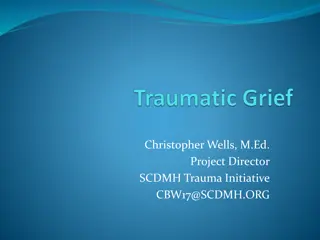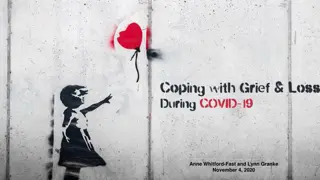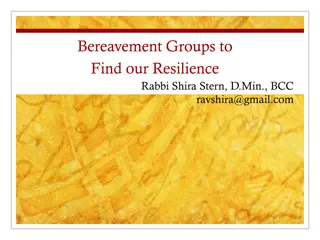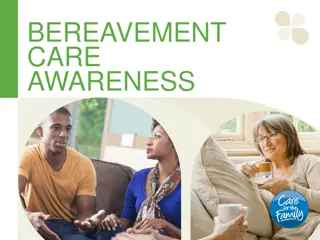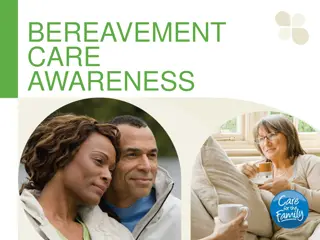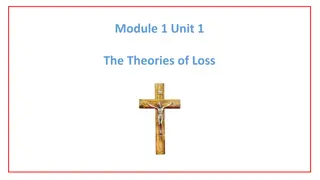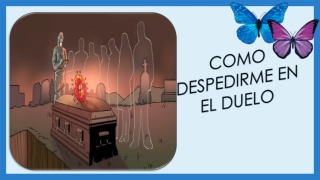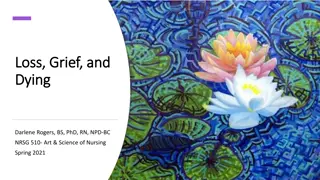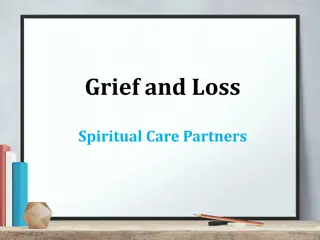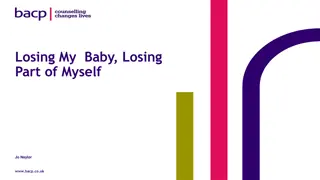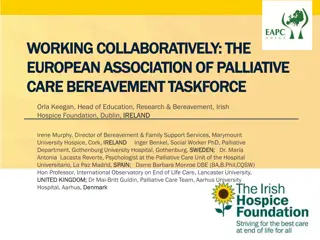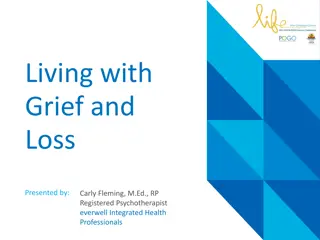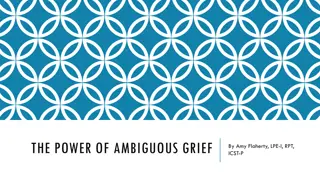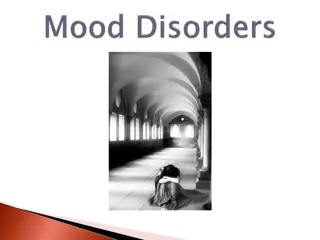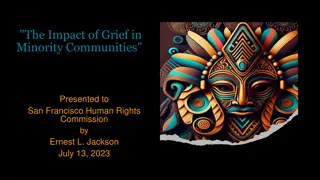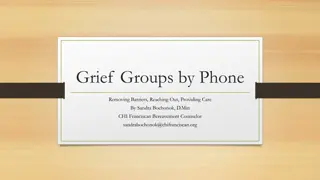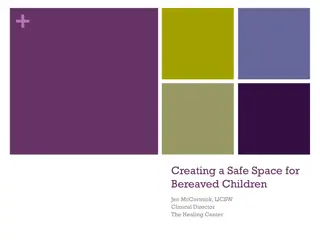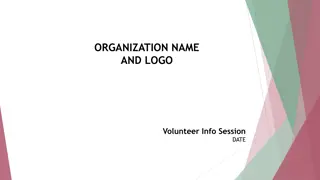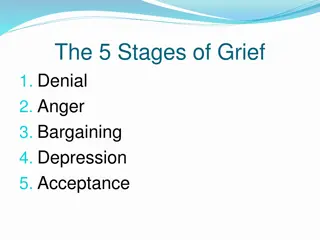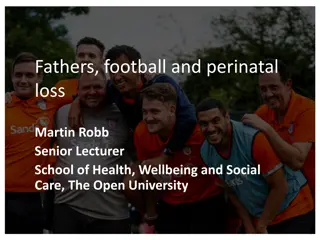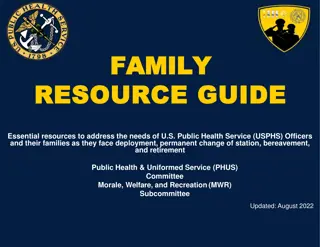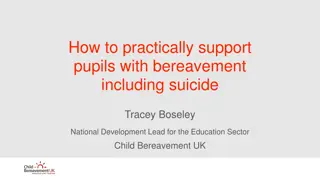Understanding Bereavement, Grief, and Loss: Historical Perspectives and Contemporary Models
Explore the concepts of bereavement, grief, and loss through the historical perspectives of Freud's Melancholia and Elizabeth Kubler-Ross's Stage Model. Understand the significance of these terms, their impact on individuals experiencing loss, and the evolution of grief and loss models over time.
Download Presentation

Please find below an Image/Link to download the presentation.
The content on the website is provided AS IS for your information and personal use only. It may not be sold, licensed, or shared on other websites without obtaining consent from the author. Download presentation by click this link. If you encounter any issues during the download, it is possible that the publisher has removed the file from their server.
E N D
Presentation Transcript
Bereavement, Grief & Loss Revd Dr Paul Fitzpatrick winterbirder@outlook.com
Significant Terms BEREAVEMENT: to have lost someone or something, typically through death; from the Old English: bereafian To have been deprived GRIEF: Deep or intense sorrow LOSS: Uncertain what to do: Bewildered; from Old English losian to be destroyed
Usage In accordance with sociological/thanatological academic practice: Bereavement will be used in this presentation to describe or explain the process of significant loss Grief and Grieving will be used in the exploration of the emotional reaction to acute loss, and the term Loss itself, will be used as defined by the CED and common usage Note: There will always be some crossover and overlap in the terms and I have been careful to apply a compassionate usage where ever possible; we have all, experienced these definitions in our lives, which has, to some degree, shaped and defined us
Freud: Melancholia: 1918 Perception that significant loss (not just death), was in essence an invested energy that needed to be recaptured. That done, the affected person would then move on or achieve closure Recovery model where grief is essentially seen as an illness or an obstacle Lacks significant clinical or proven evidence base, but supports, in small part a far more complex loss model Despite its flaws, it formed the dominant Grief and Loss model for the next 60 years and is still used by some Psychoanalysts today
Elizabeth Kubler-Ross: Stage(s) Model Five stage model of Grief suggests that people pass through, Denial, Anger, Negotiation, Depression and Acceptance, before recovering from Grief Obvious Freudian Recovery Model Developed without clinical guidelines, ethical approval or participant consent, on a terminal ward in the USA (1969) where Kubler-Ross was a psychiatrist Multiple adaptions and frequent new stage models in the US Death Model, not bereavement: Lacks clinical evidence base but frequently used due to simplicity of operation
Colin Murray-Parkes: Psychosocial Transitions CMP worked with Bowlby on Attachment Theory with Children, but developed his PST model after conducting a ten year research process with 90 widows/widowers from East London 1979-90 Complex model but in essence he identified that social attachment in multiple forms promotes personal stability. The loss of one of these bonds (or attachments) results in a period of instability (Grief/Loss) until, crucially, that bond is re-established in a different form
Colin Murray-Parkes: PST 2 Model has a strong evidence base and has been repeatedly replicated. Whilst it owes something to Freud's theories, it has a proven adult significance in terms of attachment and provides early evidence for Continuing Bond Theory which emerged in the 1990s Inadvertently Parkes also evidences the role of Narrative Identity which is central to contemporary understanding of bereavement and grief Parkes work provides the basis of much current research, including significant cultural adaptions to grief, and he remains a significant researcher and professor of psychiatry today
Silverman (et-al.) Continuing Bond Theory (CBT) Published in 1996, CBT changed the way bereavement, grief and loss were perceived and processed across the world Completely dissociated from Freud and entirely evidenced, the CBT research team suggested that the bereaved do not release , let go , seek completion or move on ; nor do they suffer dis- attachment. Instead healthy grief requires a Bond with the dead, or significant loss, to continue. The Bond in this case remains but in an altered and adapted form, thus completely reversing traditional theories of grief and loss Grief is consequently a normal healthy process
CBT & Narrative Identity Contemporary researchers have taken this process further, identifying the process of Grief Narration , values, influences and memories which narrate and function grief and loss Utilising short term and long term memory neuroscience, researchers have identified individualised, subjective and personal memory processes which in turn shape individual identity It is critical to understand that this is not a fixed process but a fluid and changing dynamic. Grief in this process, is less like a book with fixed personal narrative chapters, but much more tidal ; formed from changing emotions, values and memories which shape our identities and what we hold to be true and of importance
Grief Narratives 2 Stories have beginnings, middles and ends; narratives do not: They are formed in a fluid, individualised and constantly evolving fashion; what we held true yesterday about ourselves may not be what we hold true today Grief is obviously impacted in this process; over time we do not lose our memories, love and other emotions, they evolve and change with us. We retain a bond with our loss, fluid and dynamic, and it is this, that gives us our personalised and individual identities. Grief is in this case a form of renewal not memory disposal
Stories & Narratives 3 Narrative and story are vital in this process, both internally and externally. It is not coincidental that the most successful children's authors from Harry Potter to Palver s Wolf Boy series all have different forms of loss as their core subjects This is also true of adult fiction, seven of the last ten Booker winners have significant loss as their core subject matter People instinctively understand, relate to, and indeed grow with narration around death and loss. One of the core therapeutic tools for psychologists working with refugees who have been traumatised, is reading groups: this may also be true for those who are hurting from Corvid moving forward
Culture in Grief & Loss The importance of culture and religious identity cannot be over emphasised; nor can its neglect from many MH practitioners. 90% of the world hold to a Deity yet some contemporary psychology textbooks consider this belief/practice to be a sign of Mental Illness. Little wonder then that cultural adaptions to death, grief and loss are frequently misunderstood or misinterpreted; or that some people of faith do not seek conventional services for support at all This is a highly specialised area that is essential in a city such as Cardiff with its major international footprint. It is important not to make assumptions; if in doubt, ask advice
Cultural Narrative and Loss Catastrophic loss Need for identity Need for belonging Borum 2004
Belief and Culture: Main Points The need to belong and to have a stable evolving identity is a core essential for sound mental health and wellbeing It is compromised when individual beliefs and cultural norms are challenged, ignored or disrespected by a lack of understanding Grief and loss magnifies this process and can rapidly promote individual instability and group marginalisation What we value, what we believe, who we are, Matter
How to Hear; What to Say Firstly don t panic, don t try to use strict or prescribed models; we are first and foremost individuals Good bereavement care is based upon listening and hearing: Listening is giving people your undivided attention, hearing is understanding what they say. For the vast majority of people this is all they need; self expression and narration, permit over time, a new and emerging bond and identity. It really is that simple Counselling, whilst critical in complex or compacted grief situations, is often counter indicated in early grief Process
How to Hear; What to Say 2 Don t try to fix the grief resist the need to try to stop someone who is crying or over comfort them, sitting with someone who is in pain is honouring that pain Please remember that people grieve differently, there is no single right way ; we are individuals and so is our way of processing hurt and loss
What if a simple risk assessment Being upset or low is perfectly normal; if however, a grieving person express a wish to self harm, or is perceived to be a risk to themselves or anyone else, you must refer urgently Multiple personal death or loss events, either immediate or historic, pose significant risk and should be dealt with in a therapeutic setting Never agree to absolute confidentiality; it compromises your (and their) safety and breaches appropriate boundary settings Do not be afraid of death or grief. This is a hard time but is a normal and healthy process in the majority of cases, if in doubt ask
Finally Analysing Doesn t Work
References and Additional Material Common Thanatological usage adapted from the Centre for the Study of Death and Society: (CDAS) Bath University Academic reference list available separately upon request OED and CEP references used, with some Oxford Guide to Style usage also acknowledged


